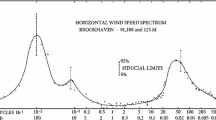Abstract
Nimbus 7 LIMS geopotential height data are utilized to infer the rotational wind distribution in the Northern Hemisphere stratosphere and lower mesosphere during a period of substantial wave-mean flow interaction in January, 1979. Rotational winds are derived from the application of a successive relaxation numerical procedure which incorporates the spherical polar coordinate iterative algorithm ofPaegle andTomlinson (1975) for the nondivergent nonlinear balance equation. Optimum convergence of the numerical solutions is found to occur when under-relaxation is utilized. The LIMS height analyses were also latitudinally smoothed and constrained to obey the ellipticity criterion for spherical coordinates. The balanced winds are compared with geostrophically derived values and within situ radiosonde reports for 100 mb to 10 mb over Berlin.
From a localized perspective, the Berlin-LIMS comparison indicates that radiosonde and balanced wind vectors exhibit somewhat closer agreement in direction than is associated with the geostrophic estimates. However, substantial quantitative differences between radiosonde, balanced, and geostrophic wind speeds are also evident, suggesting that caution should be exercised in the local application of derived winds, as for example in the quantitative interpretation of trajectories derived from satellite height analyses during periods of enhanced stratospheric wave activity.
On a longitudinally averaged basis, balanced zonal-mean wind speeds are typically 20% weaker than geostrophic values in polar latitudes, and as much as 50% weaker in tropical and midlatitude regions. Meridional balanced wind velocities, at a given longitude, are generally within ±10% of geostrophic values. Although these alterations in horizontal wind components result in only modest differences between balanced and geostrophic meridional eddy heat fluxes, a more substantial change appears in the meridional eddy momentum flux analysis. The corresponding patterns of Eliassen-Palm flux divergence are found to be somewhat more (less) intense for the balanced wind case in the stratosphere (lower mesosphere) in polar latitudes.
Similar content being viewed by others
References
Anderson, D. A., J. C. Tannehill, andR. H. Pletcher,Computational Fluid Mechanics and heat Transfer (McGraw-Hill 1984) 599 pp.
Andrews, D. G. (1987),On the interpretation of the Eliassen-Palm flux divergence, Quart. J. Roy. Meteor. Soc.113, 323–338.
Bijlsma, S. J., andR. J. Hoogendoorn (1983),A convergence analysis of a numerical method for solving the balance equation, Mon. Weath. Rev.111, 997–1001.
Blackshear, W. T., W. L. Grose, andR. E. Turner (1987),Simulated sudden stratospheric warming; synoptic evolution, Quart J. Roy. Meteor. Soc.113, 815–846.
Boville, B. A. (1987),The validity of the geostrophic approximation in the winter stratosphere and troposphere, J. Atmos. Sci.44, 443–457.
Clough, S. A., N. S. Grahame, andA. O'Neill (1985),Potential vorticity in the stratosphere derived using data from satellites, Quart. J. Roy. Meteor. Soc.111, 335–358.
Elson, L. E. (1986),Ageostrophic motions in the stratosphere from satellite observations, J. Atmos. Sci.43, 409–418.
Gille, J. C., andJ. M. Russell III (1984),The limb infrared monitor of the stratosphere: Experiment description, performance, and results, J. Geophys. Res.89, 5125–5140.
Grose, W. L. (1984)Recent advances in understanding stratospheric dynamics and transport processes: Application of satellite data to their interpretation, Adv. Space Res.4, 19–28.
Grose, W. L., T. Miles, K. Labitzke, andE. Pantzke (1988),Comparison of LIMS temperatures and geostrophic winds with Berlin radiosonde temperature and wind measurements, J. Geophys. Res.93, 11217–11226.
Grose, W. L., andA. O'Neill (1989),Comparison of data and derived quantities for the middle atmosphere of the Southern Hemisphere, Pure Appl. Geophys.130, 2/3, 195–212.
Houghton, D. D. (1968),Derivation of the elliptic condition for the balance equation in spherical coordinates, J. Atmos. Sci.25, 927–928.
Iversen, T., andT. E. Nordeng (1982),A convergent method for solving the balance equation, Mon. Wea. Rev.110, 1347–1353.
Kennedy, J. S., andW. Nordberg (1967),Circulation features of the stratosphere derived from radiometric temperature measurements with the TIROS VII satellite, J. Atmos. Sci.24, 711–719.
Paegle, J., andE. M. Tomlinson (1975),Solution of the balance equation by Fourier transform and Gauss elimination, Mon. Wea. Rev.103, 528–535.
Randel, W. J. (1987),The evaluation of winds from geopotential height data in the stratosphere, J. Atmos. Sci.44, 3097–3120.
Remsberg, E. E. andJ. M. Russell III,The near global distributions of middle atmospheric H2Oand NO2 measured by the Nimbus 7. LIMS experiment, inTransport Processes in the Middle Atmosphere (eds. G. Visconti and R. Garcia) (Reidel 1987) pp. 87–102.
Robinson, W. A. (1986),The application of the quasi-geostrophic Eliassen-Palm flux to the analysis of stratospheric data, J. Atmos. Sci.43, 1017–1023.
Author information
Authors and Affiliations
Rights and permissions
About this article
Cite this article
Miles, T., Grose, W.L. Comparison of geostrophic and nonlinear balanced winds from LIMS data and implications for derived dynamical quantities. PAGEOPH 130, 319–342 (1989). https://doi.org/10.1007/BF00874463
Received:
Revised:
Accepted:
Issue Date:
DOI: https://doi.org/10.1007/BF00874463




